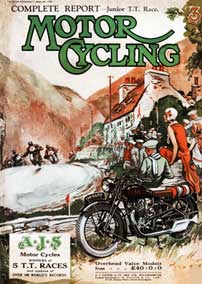TT Racing in the 1930s
The 1930s were a decade in which the Isle of Man TT races became the predominant motor-cycling event in the racing calendar, and are seen as the classic era of racing in the Isle of Man. A number of changes occurred to the Mountain Course during the 1930s, with extensive road widening on the A18 Mountain Road and the removal of the hump-back bridge at Ballig for the 1935 racing season in the Isle of Man. 1930 magazine cover featuring AJS motorcycles racing in the Isle of Man TT The 1930s produced a number of changes for the Isle of Man TT Races in which the event became more commercialised. The George Formby film No Limit (1936 film) used the 1935 Isle of Man TT races as a backdrop for filming. Also, the 1930s saw increasing use of the TT races by motorcycle manufacturers to show-case their products. As a result, the 1930s produced an increased pace of motorcycle development, with the introduction of supercharging and over-head camshaft engines, plunger rear suspension, and telescopic front forks.[24] These technological improvements were played out by the different British motorcycle manufacturers such as AJS, Rudge, Sunbeam, and Velocette gradually being eclipsed by the pre-eminence of the works Nortons. Increasing interest by foreign manufacturers in the 1930s produced works entries from BMW, DKW, NSU, Bianchi and Moto Guzzi at the Isle of Man TT races. The increased competition produced a frantic search for more engine power and better handling. At first, better handling was the best way to produce faster lap times, but as the power advantage of supercharged machines increased, their lap speeds began to match and finally overtook the others. Consequently, by 1938, most British manufacturers had a supercharged machine under test. Increased professionalism by the TT riders during the 1930s was the reason for Stanley Woods parting with Norton motorcycles, despite the winning of four TT races in 2 years, over the issue of prize money. Woods joined Husqvarna, and later rode for Moto Guzzi and Velocette. The 1930 Senior TT Race was won by Rudge with Wal Handley becoming the first TT rider to win in all three major TT Race classes and the first lap under 30 minutes of the Mountain Course. The 1931 TT Race meeting was again dominated by the battle between Rudge and Norton motorcycles. The 1931 Senior TT Race provided Tim "Percy" Hunt with a popular Junior/Senior double win and also produced the first 80 mph lap by Jimmy Simpson on a Norton motorcycle. The 1932 TT Race meeting was watched by Prince George, Duk

of Kent the first royal visitor to the Isle of Man TT Races. The 1932 Senior TT Race provided Stanley Woods with the Norton Habit[25] and another Junior/Senior double win. Also on the first lap, Wal Handley, riding for Rudge, crashed at the 11th Milestone sustaining a back injury and retired. The place on the TT course where the incident occurred was renamed Handley's Corner. The 1933 Senior TT Race gave Stanley Woods another Junior/Senior double win, with works Nortons taking the first four places, ridden by Jimmy Simpson, Tim Hunt and Jimmie Guthrie. The 1934 TT Races was another double Junior/Senior win for Jimmie Guthrie and the last TT race for Jimmy Simpson. For the 1935 TT Races, Stanley Woods provided another surprise by moving to Moto Guzzi and was a debut event for the Italian Omobono Tenni. The 1935 Senior TT Race produced one of the most dramatic TT races, as the Moto Guzzi pit attendants made preparations for Stanley Woods to refuel on the last lap, but Woods went straight through the TT grandstand area without stopping and went on to win by 4 seconds from Jimmie Guthrie. Despite disqualification during the 1936 Junior TT Race, Jimmie Guthrie won the 1936 Senior TT Race, avenging his dramatic defeat the previous year. The 1937 TT Races produced the first foreign winner, when the Italian TT rider, Omobono Tenni won the Lightweight race. Jimmie Guthrie was killed a few weeks later while riding for the Norton team during the 1937 German Grand Prix. The 1938 TT Races produced the first German winner when Ewald Kluge won the 1938 Lightweight TT Race and became the first overall European Motor-Cycle Champion for the works DKW team. In the 1939 Isle of Man TT Races, the works Norton team did not compete, as the Norton factory were changing over to war production. Although the 1938 model Norton was provided to Harold Daniell and Freddie Frith to race, the 1939 TT Races provided Stanley Woods with a tenth TT win, aboard a Velocette in the Junior TT Race and a well judged first win for Ted Mellors riding a Benelli in the 1939 Lightweight TT Race. The Blue Riband race of the Isle of Man TT Races was won for the first time by a foreign competitor when Georg 'Schorsch' Meier won the 1939 Senior TT Race riding for the factory BMW motorcycle team. In the 1930s, TT winners were allowed to keep the trophies for a year. The 1939 factory BMW motorcycle that won the 1939 Senior TT Race spent the war years buried in a field, and the Senior TT trophy was discovered displayed in a shop in Vienna at the end of the war.